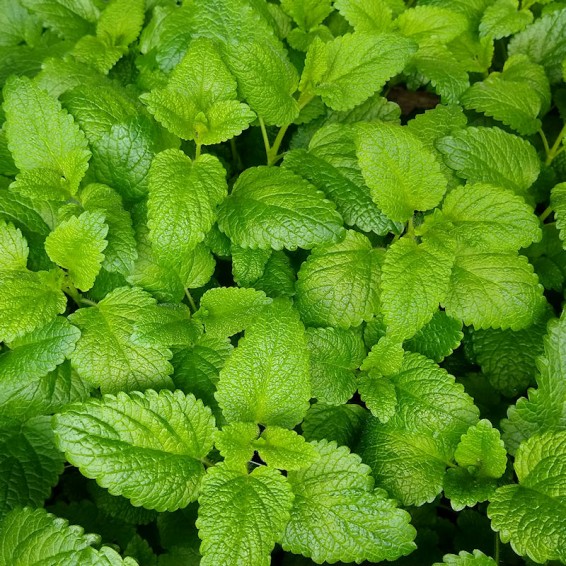Organic Lemon Balm Seeds
- HOW TO GROW
- FAST FACTS
- REVIEWS
HOW TO GROW
Sowing: To start lemon balm indoors in a flat, sow on the surface of soil about 6 weeks before the last spring frost; provide moderate heat, but keep away from the hottest rays of sunlight. For best results, water lightly with a spray bottle or something similar. Transplant outdoors as soon as the seedlings grow big enough to handle, or after the last spring frost. To direct sow after the last frost, plant the seeds on the surface of the soil and keep it evenly moist until germination, which should take place within 2-3 weeks. Lemon balm prefers well drained or sandy soil and partial shade, but can grow in full sun. With proper handling, lemon balm grows well in containers.
Growing: Water regularly, but do not over water. Mature lemon balm tolerates drought conditions. Control weeds while the seedlings are becoming established. Lemon balm attracts bees, birds, and butterflies; it can become rather invasive if left to spread. To prevent this, remove the flowering stalks before they go to seed.
Harvesting: Harvest fresh leaves as needed during summer and fall. Lemon balm regrows well after cutting, even coming back after being cut nearly to the ground. For healthy growth, however, do not remove more than half of the plant's growth at one time. The flavor of lemon balm reaches its peak immediately before flowering, and the best time to harvest is in the morning after the dew has dried. Fresh leaves have the best flavor, though they can be dried or frozen; dry them within 2 days at a high temperature to prevent mold.
Seed Saving: Remove individual flowering stalks as they begin to dry and develop seed. Spread them out to dry away from direct sunlight. Shake out the seed and store it in a cool, dry place.
FAST FACTS
Common Names: Balm, Common Balm, Balm Mint
Latin Name: Melissa officinalis
Species Origin: Mediterranean, Europe, Central Asia
Type: Open Pollinated, Heirloom, Warm Season
Life Cycle: Perennial
USDA Zones: 4, 5, 6, 7, 8, 9
Seeds per Ounce: 46,200
Planting Method: From Transplant
Sunlight: Full Sun
Height: 30 Inches
Color: Green
Bloom Season: Blooms Early Summer, Blooms Late Summer
Uses: Attracts Pollinators, Attracts Honeybees, Attracts Butterflies, Aromatic, Deer Resistant
Growing for medicinal
I can't wait to grow these this year for medicinal use!
DESCRIPTION
HOW TO GROW
Sowing: To start lemon balm indoors in a flat, sow on the surface of soil about 6 weeks before the last spring frost; provide moderate heat, but keep away from the hottest rays of sunlight. For best results, water lightly with a spray bottle or something similar. Transplant outdoors as soon as the seedlings grow big enough to handle, or after the last spring frost. To direct sow after the last frost, plant the seeds on the surface of the soil and keep it evenly moist until germination, which should take place within 2-3 weeks. Lemon balm prefers well drained or sandy soil and partial shade, but can grow in full sun. With proper handling, lemon balm grows well in containers.
Growing: Water regularly, but do not over water. Mature lemon balm tolerates drought conditions. Control weeds while the seedlings are becoming established. Lemon balm attracts bees, birds, and butterflies; it can become rather invasive if left to spread. To prevent this, remove the flowering stalks before they go to seed.
Harvesting: Harvest fresh leaves as needed during summer and fall. Lemon balm regrows well after cutting, even coming back after being cut nearly to the ground. For healthy growth, however, do not remove more than half of the plant's growth at one time. The flavor of lemon balm reaches its peak immediately before flowering, and the best time to harvest is in the morning after the dew has dried. Fresh leaves have the best flavor, though they can be dried or frozen; dry them within 2 days at a high temperature to prevent mold.
Seed Saving: Remove individual flowering stalks as they begin to dry and develop seed. Spread them out to dry away from direct sunlight. Shake out the seed and store it in a cool, dry place.
FAST FACTS
Common Names: Balm, Common Balm, Balm Mint
Latin Name: Melissa officinalis
Species Origin: Mediterranean, Europe, Central Asia
Type: Open Pollinated, Heirloom, Warm Season
Life Cycle: Perennial
USDA Zones: 4, 5, 6, 7, 8, 9
Seeds per Ounce: 46,200
Planting Method: From Transplant
Sunlight: Full Sun
Height: 30 Inches
Color: Green
Bloom Season: Blooms Early Summer, Blooms Late Summer
Uses: Attracts Pollinators, Attracts Honeybees, Attracts Butterflies, Aromatic, Deer Resistant
Reviews
Review
Growing for medicinal
I can't wait to grow these this year for medicinal use!





